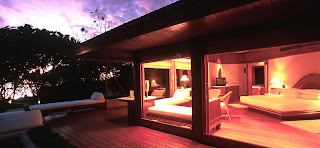



A private island, where sea and sky meet as one, where velvet white sand is caressed by the lap of crystal water, where palms bow to vermillion bougainvillea in tropically kissed vegetation, where nature’s hand streaks the sun’s iridescences on its unbridled canvas, where night skies are admired beside the crackle of a ‘tepee’ beach fire, where sleep is submerged in pristine white, where luxury is defined by its earth-given beauty, where peace embraces its island host. This place is Amanpulo, in the Philippines, a realisation of a dream.
Amanpulo is a stunning private island luxury hideaway, set along a pristine white beach and cocooned by palm trees. Turquoise seas, coral reefs and diving, scuba-diving, cruising opportunities await. Relax in your luxury treetop casita or overater bungalow accommodation and be pampered at the spa between bouts of underwater adventure and water sports. -Philippine Travels












